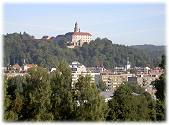The town of Náchod
The town of Náchod intriduces itself
 The town of Náchod is situated 346 metres above sea level on both river-banks of river Metuje and it is the town zone of conservation. First written mentions of the town originated in 1254.Little town had consecutively spread over the town walls, significant boom occured in the end of 18th century together with the expansion of textile industry. The town has recently been a natural, historical, tourist, administrative and industrial centre of the area - from the entry "Branka = Gate" up to the whole Broumov edge. There are many monuments here in the town - Renaissance castle with French garden, St. Lawrence´s gothic church in Masaryk square, the old baroque town hall, the new neo-renaissance town hall, the post office.
The town of Náchod is situated 346 metres above sea level on both river-banks of river Metuje and it is the town zone of conservation. First written mentions of the town originated in 1254.Little town had consecutively spread over the town walls, significant boom occured in the end of 18th century together with the expansion of textile industry. The town has recently been a natural, historical, tourist, administrative and industrial centre of the area - from the entry "Branka = Gate" up to the whole Broumov edge. There are many monuments here in the town - Renaissance castle with French garden, St. Lawrence´s gothic church in Masaryk square, the old baroque town hall, the new neo-renaissance town hall, the post office.
Náchod is the birthplace of Czech writer and publisher in exile Josef Škvorecký, born 1924, dramatist and satirist Vratislav Blažek, who lived in time from 1925 till 1973. Also some novels written by Alois jirásek are related to Náchod. There is a regional museum and Gallery of visual arts here. Náchod is a border town with the direct relationship to Kudowa Zdroj and other spa towns in Klodzko land, e.g. Dušniki Zdrój and Polanica Zdrój.
History
 In the early Middle Ages, in the 11th century and perhaps even earlier, there was a trail connecting our country with neighbouring Poland. There was a Guard Gate at the very borderline, and beneath, a small settlement of guards with an ancient St. John the Baptist Church. For the first time we have learnt about the Gate from Kosmas Chronicle record about Prince Vratislav II, who had called a land´s assembly of knights there..
In the early Middle Ages, in the 11th century and perhaps even earlier, there was a trail connecting our country with neighbouring Poland. There was a Guard Gate at the very borderline, and beneath, a small settlement of guards with an ancient St. John the Baptist Church. For the first time we have learnt about the Gate from Kosmas Chronicle record about Prince Vratislav II, who had called a land´s assembly of knights there..
About two centuries later a border castle on the hill above the Metuje river came into being, then a town called Náchod appeared in the valley beneath.Landlord Hron of Náchod from House of Načeratic was the first-known owner of both, the castle and the town. Then, as the centuries, rich of peace and wars, were passing by, there was a long line of feudal lords to whom the town belonged. Among them was the Czech King John of Luxembourg, Hussite leader Jan Kolda of Žampach and even the so called Hussite King George of Poděbrady. The Smiřickýs rebuilt the late Gothic castle into The Renaissance chateau in the 16th century, and the town flourished under their rule, but unfortunately not for long. During the Thirty Years´War, the Italian noble House of Piccolomini became the new lord of Náchod. Its main representa- tive - Octavio, Emperor´s Generalissimus - called on Italian builders and had the smaller Renaissance chateau rebuilt into a magnificent Baroque Duke´s seat. Foreign aristocracy, however, became known as the dependents´oppressor which resulted in a huge peasant upheaval against the establishment. Nothing is eternal. The Piccolominis died out and their place was taken by the House of Curland with the art-loving Peter, Duke of Curland. The Náchod castle revived . The duke´s theatre was busy again , even Don Giovanni by famous Mozart - the opera of all operas - could be heard there. Also the dependents´matters under the new lord were handled in a progressive way. Peter´s daughter Catherine Wilhemine, Duchess of Sagan, whose rule marked the first forty years of the 19th century, was a very important lady and played a considerable role in European diplomacy. Her memory is for us, commemorated as the "Madam Duchess" from the most beautiful novel of 19th century , "Grandmother" by Božena Němcová.

